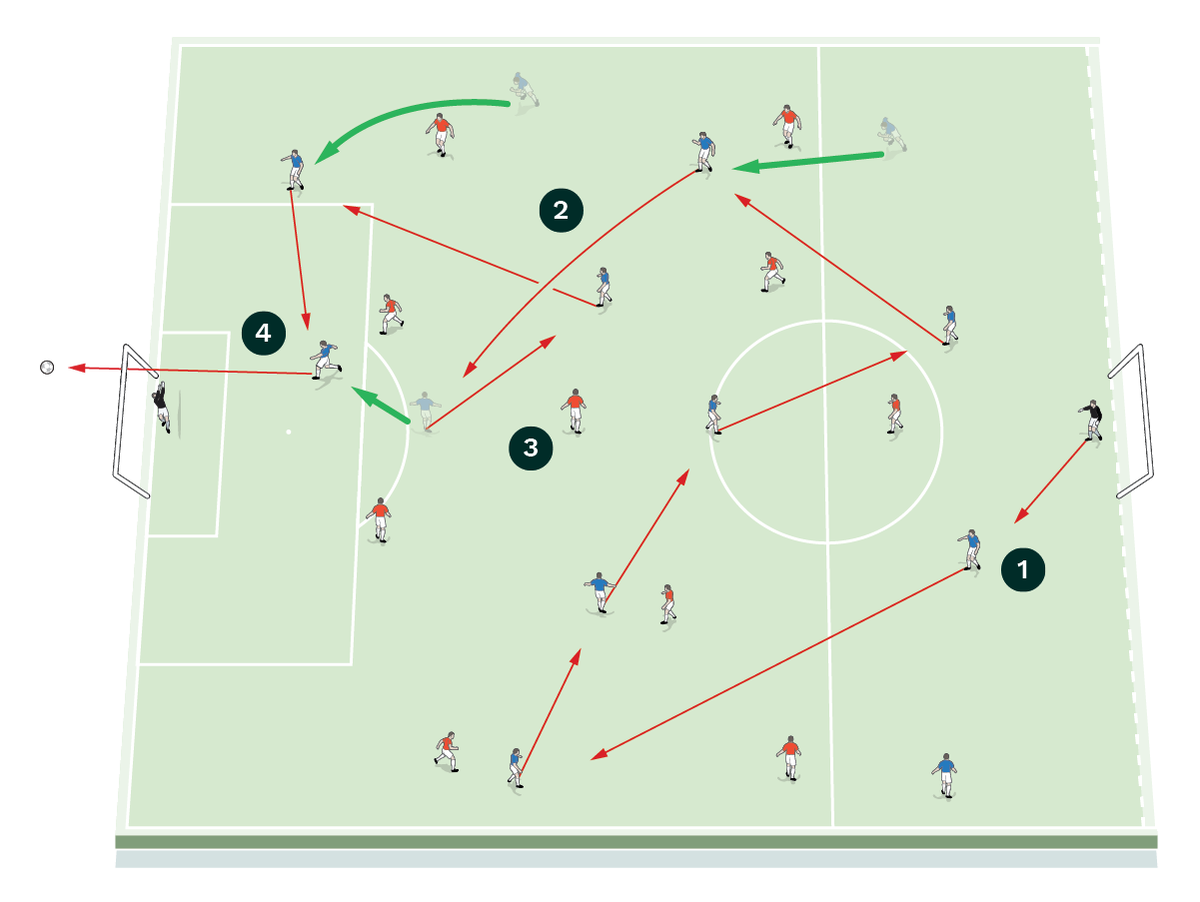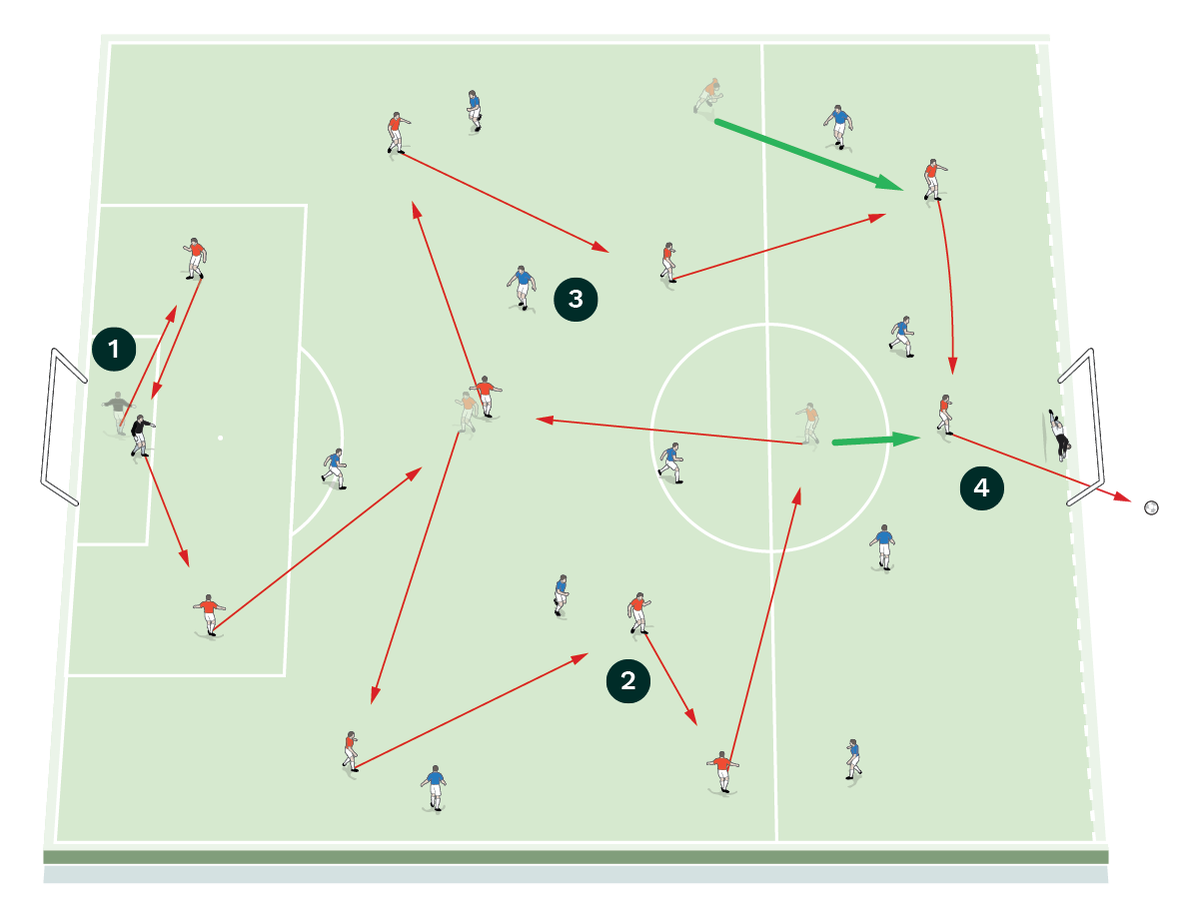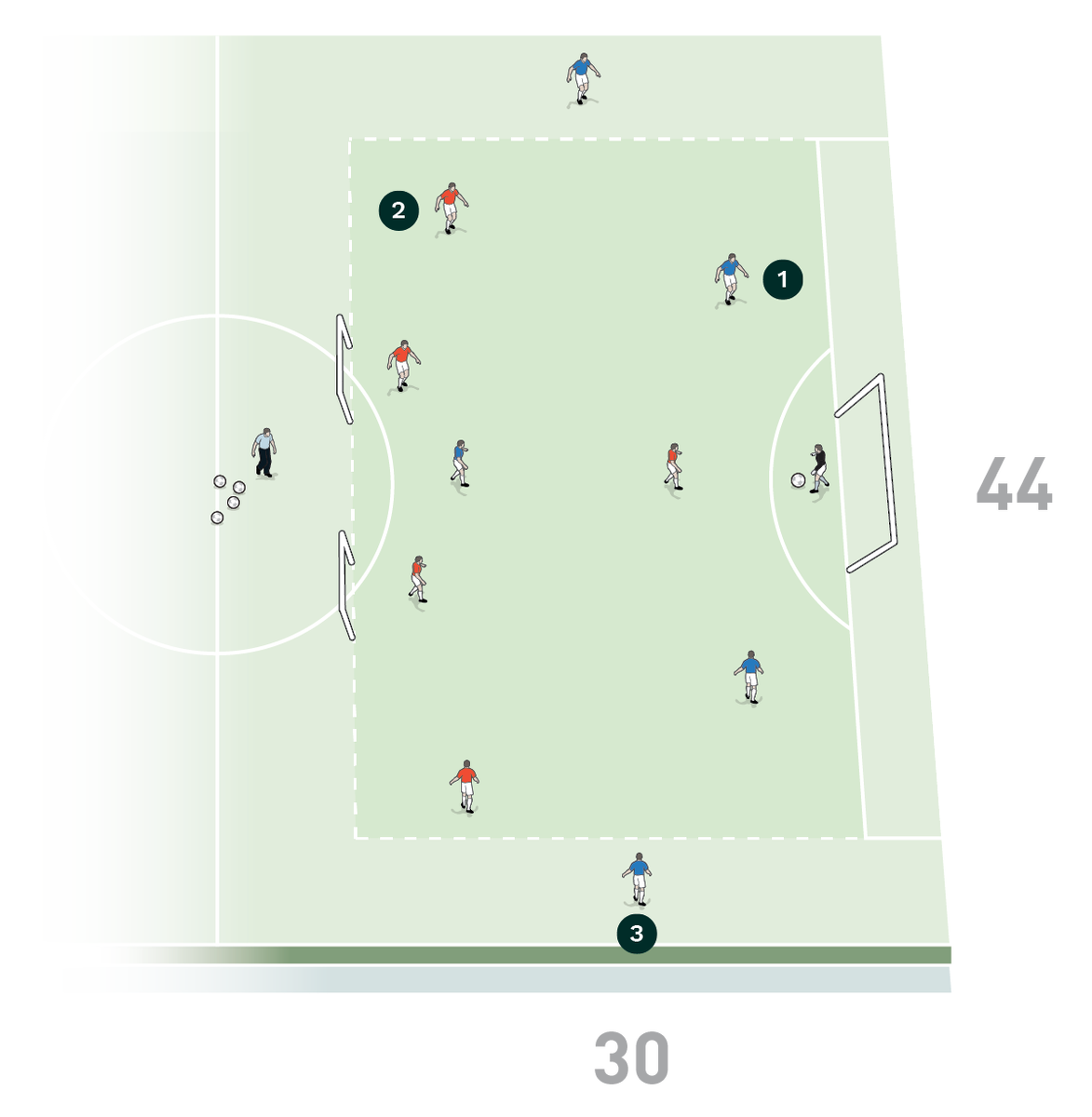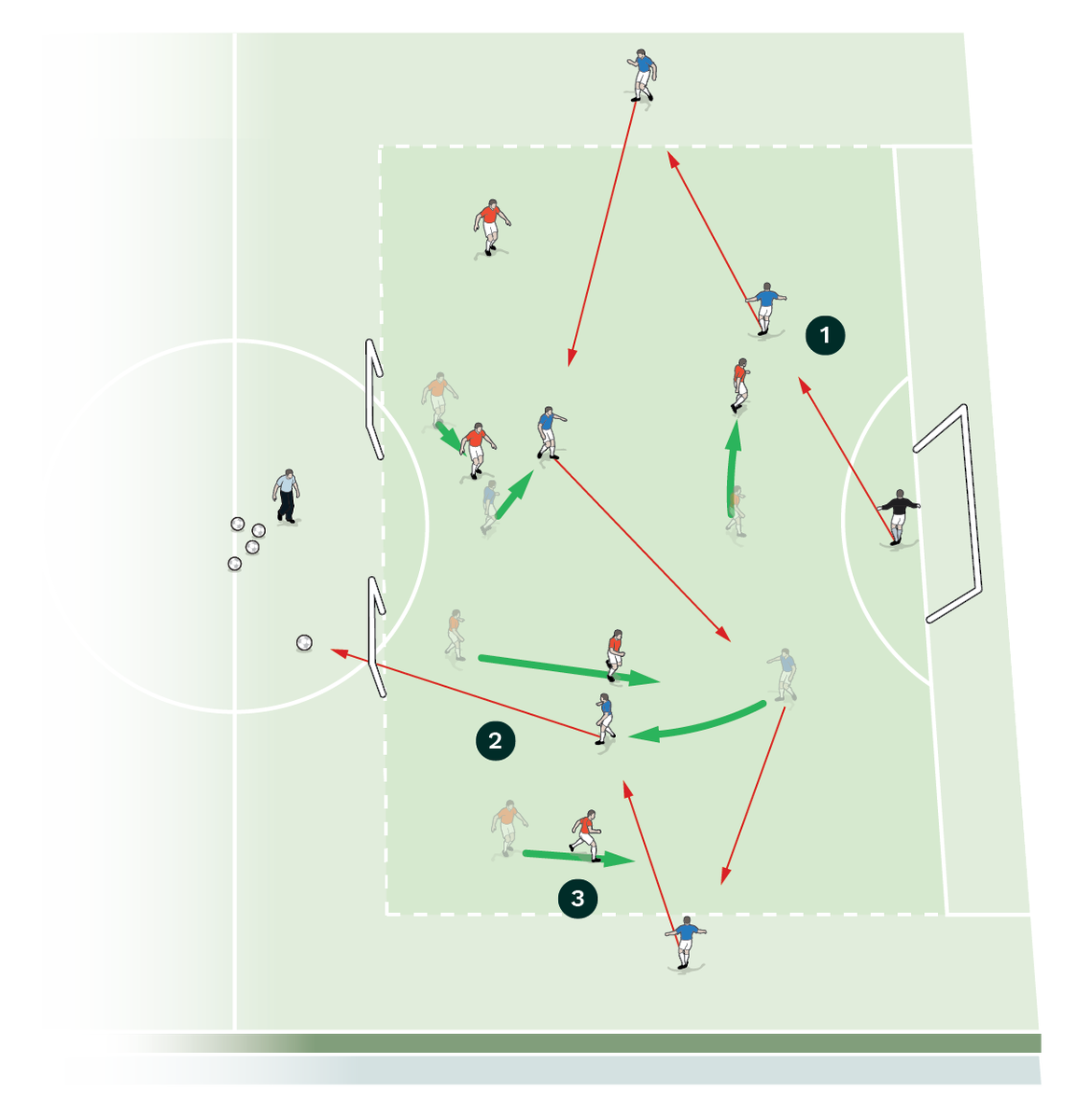




OUR BEST EVER OFFER - SAVE £100/$100
JOIN THE WORLD'S LEADING PROFESSIONAL DEVELOPMENT PROGRAMME
- 12 months membership of Elite Soccer
- Print copy of Elite Player & Coach Development
- Print copy of The Training Ground
You are viewing 1 of your 1 free articles
Play around to play through
This session has a focus on attacking strategy and we used it prior to a Champion’s League game. It allows the team to execute our build up and creation patterns against our upcoming opponent’s shape, focusing on our movements off the ball and on the supporting angles for the player in possession. It looks to create space centrally by maintaining width and wide rotations.
| Area | Full pitch |
| Equipment | Balls, bibs, cones, 4 small goals, 2 full size goals |
| No. of Players | 20 players + 2 goalkeepers |
| Session Time | Basic actions: 12mins Passing Exercises 1 & 2 (simultaneous): 18mins Position game: 20mins Tactical 11v11 game: 15mins |
This session is designed to allow the entire squad of players maximum touches on the ball to express their creativity and solidify our attacking strategy for the upcoming match. It’s designed for players to build their confidence in the areas we are trying to exploit. It also has an element of competitiveness to it and ensures the entire squad feel prepared for the game – mentally, physically and tactically. The session’s structure allows for attacking details and content to be implemented, dependant on the coach’s preference and philosophy.
A version of this session will be run when we are looking to focus on our attacking phases of play, specifically when we need to create and exploit specific spaces. The structure will always incorporate the opponent’s shape to allow the team to see where the spaces are that we are looking to exploit, using our specific movements and rotations. This session structure is useful when playing teams who are compact centrally, and movement and rotations are needed to help move the them and disrupt their structures, to play around them and through them.
BASIC ACTIONS
Basic actions are exercises with the ball that can be performed with or without opponents. If opponents are involved its passive pressure, with players looking to execute simplified football actions. This is an opposed basic action practice that looks to implement our tactical patterns of play in the creation areas of the pitch.
We set up on two-thirds of a pitch with a full-size goal and a goalkeeper at each end. We’re using 20 outfield players split into two teams of 11 including goalkeepers. The blue team are set up in our 4-5-1 formation and the red team are set up in the upcoming opposition’s formation, in this case also 4-5-1.
Play starts with the blue goalkeeper. The blue team moves the ball, looking to execute rotation patterns to work the ball to the opposition goal and pass it into the back of the net (as opposed to shooting), as shown [1a].
[1a]

- The blue team are set up in a 4-5-1 formation and they start play with a pass out from their goalkeeper
- The blue team moves the ball and looks to execute rotation patterns to work the ball to the opposition goal
- The red team replicates the upcoming opposition’s mid-block/pressing shape. They cannot tackle but they can intercept mis-placed passes
- The blues must pass the ball into the back of the net rather than shoot
The red team replicates the upcoming opposition’s mid-block/pressing shape. They cannot tackle, but they can intercept misplaced passes.
Once the ball has been passed into the net, or an interception has been made, possession changes hands.
“This activity starts with reduced intensity and smaller passing patterns, and as the players become action-ready the intensity will increase”
Now the red team looks to execute rotation patterns to work the ball towards the goal, while the blue team sets up in the opposition’s defending shape, as shown [1b].
[1b]

- Once the ball has been passed into the net, or an interception has been made, possession changes. Here the red keeper passes out from the back to start play
- Now the reds look to execute rotation patterns to work the ball to the blue team’s goal
- The blue team sets up in the upcoming opposition team’s defending shape but they are not allowed to tackle
- Here the red striker passes the ball into the net
After six minutes, the teams change ends, so they both get a chance to implement the patterns at each end of the pitch.
This part of the session will start off with reduced intensity and smaller passing patterns, and as the players become more action-ready the intensity of the actions will increase.
For coaches replicating this session, your own tactical formation can be implemented, focusing on your patterns of play based on your own coaching philosophy.
PASSING EXERCISE 1: BUILD-UP PHASE
For the two passing exercises, the players are split into two groups, with half the players focusing on the build-up phase and half focusing on the create and finishing phase. The two activities are run concurrently with one playing area set up on one half of a pitch and the other playing area set up on the other half of the pitch.
For the build-up phase passing exercise, we set up on half a pitch marking out a playing area the width of the penalty box. It is 30 yards long from the 18-yard line, with a full-size goal and a goalkeeper at one end and two small target goals at the other end.
We’re using 10 outfield players split into two teams of five. The blue team looks to replicate Chelsea’s strategy, while the red team sets up in the shape of the upcoming opponents. The blue team is made up of a goalkeeper, a back four and a single pivot. The blue full backs must stay outside of the main playing area and are restricted to two touch. The red team is made up of four midfielders and an attacker, as shown [2a].
[2a]

- The blue team is made up of a goalkeeper, a back four and a single pivot. The blues look to replicate the build-up strategy of the team being coached
- The red team is made up of four midfielders and an attacker and is set up in the shape of the upcoming opponents
- The blue full backs must stay outside of the main playing area and are restricted to two touch
The ball starts and restarts with the goalkeeper each time and the blues look to work it into the small goals, while the red team looks to win the ball back and attack the big goal, as shown [2b].
[2b]

- The ball starts and restarts with the goalkeeper each time
- The blues look to work the ball forward and pass into the small goals
- The red team must remain in the main playing area and they can’t press the outside players. They look to win the ball back and if they succeed they must counter-attack the main goal and try to score
As a progression, the blue players outside the box have their touch limitations removed and once the ball has been passed outside the main playing area to a full back, the reds can look to go outside the area to press the full back, as shown [2c].
[2c]

- As a progression, the blue players outside the box no longer have a restriction on the number of touches they can take
- Also as a progression, once the ball has been passed outside the main playing area to a blue full back, the reds can now go outside the area to press
PASSING EXERCISE 2: CREATE & FINISHING PHASE
At the same time as we run the build-up phase passing exercise, half of the players set up on the other half of the pitch for the create and finishing phase passing exercise. We set up a mirror image of the other playing area, using the width of the penalty box. The area runs 30 yards in length from the 18-yard line with a full-size goal and a goalkeeper at one end and two small target goals at the other end.
We’re using 10 outfield players split into two teams of five. The blue team again looks to replicate Chelsea’s strategy and is made up of two attacking midfielders and a front three, as shown [3a].
[3a]

- The blue team is made up of two attacking midfielders and a front three. It looks to replicate the create and finishing strategy of the team being coached
- The red team is made up of a goalkeeper, a back four and a single pivot. It is set up in the shape of the upcoming opponents
- The wide front players are restricted to two touch and they must stay outside of the main playing area initially but once the practice is underway the far side wide player can come into the area to finish from crosses
The wide front players are restricted to two touch and they must stay outside of the playing area initially, but once the practice has started the far side player can come into the area to make back post runs snd act as an additional player to finish from crosses.
The red team sets up in the shape of the upcoming opponents and is made up of a goalkeeper, a back four and a single pivot.
Play starts and restarts with a coach serving the ball into a blue midfielder from between the small goals and the blues look to attack the main goal, as shown [3b]. The reds must try to win possession of the ball and score in one of the small goals.
[3b]

- Play starts and restarts with a coach serving the ball into a blue midfielder from between the small goals
- The blues look to build an attack on the main goal
- The blue wide player on the far side from the ball come into the playing area to support the attack
- The reds press and try to win possession. If they succeed they must try to score in one of the small goals
As a progression, the blues can rotate an attacking midfielder out of the area, switching places with the wide attacker, as shown [3c]. Once the ball is passed outside the area, the reds can go outside to press the blue wide player.
[3c]

- As a progression, the blues can rotate an attacking midfielder out of the main playing area to switch places with the wide attacker
- As a further progression, when the ball is passed outside the area, the reds can now go outside to press the blue wide player
PASSING EXERCISE 3: POSITION GAME
Now we bring both of the passing exercises together, removing the four small goals from the centre of the pitch to leave a playing area the width of the penalty area between the two 18-yard lines, with a full size goal and a goalkeeper at each end. The two blue teams merge into one full team of 11 but all blue wide players (the two full backs and the two wide attackers) must remain outside the playing area. The two red teams also merge.
Play starts with a pass out from the blue keeper and we play an 11v11 game, with the blue team looking to rotate in wide areas and drag the red team out of the playing area to exploit central spaces, as shown [4a].
[4a]

- After removing the mini goals and merging the blue teams from the previous two activities, play starts with a pass out from the blue goalkeeper
- The two blue full backs and the two blue wide attackers remain outside the playing area, as they were in the previous two activities
- Both red teams from the previous two activities also merge and the reds press and try to win possession
- As before, the reds can only go outside the main playing area to press a blue wide player once the ball is there
- The blues rotate in the wide outside areas and look to pull the red team out of the main area so they can exploit central spaces
- The blues should make runs into the goalmouth area when crossing opportunities are presented
We want to see good numbers from the blue team making runs into the box when crossing opportunities are presented.
If the ball goes out of play, the team in possession restarts from their goalkeeper.
As a progression, the red team can have one player go outside of the playing area before the ball is passed out to the blue wide player, as shown [4b].
[4b]

- As a progression, the red team can have one player go outside of the playing area to press before the ball is passed out to the blue wide player
Also as a progression, the blue team must always have a minimum of one person outside the area, however it doesn’t always have to be a full back or wide attacker, as players can rotate.
We play four blocks of three minutes with a rest between.
11v11 GAME
We set up on a full pitch with a goal at each end. We’re using two full teams of 11 with the blue team set up in Chelsea’s formation, and the reds set up as the upcoming opposition. Players must implement the tactical information that has been worked on in the previous sections of the session, as shown [5].
[5]

- The blue team attacks with wide players working to stretch the area
- The pivot supports the wide player, offering an inside pass
- The blues work the ball to the left winger who crosses for the forward to finish
- The right winger makes a back post run to support the attack
COACHING POINTS
What are the key things to look out for?
In the build-up phase we want to see the attacking team’s pivot supporting players in the wide areas by offering them an inside passing option. Also, the centre backs should give depth without stopping being a passing option for the keeper.
We want to see players using the correct ball speed and switching play across the back to move the opposition. Players should use movement and ball speed to open up opportunities to pass into the small goals and if they lose possession the attacking team should counter-press quickly to stop the opponent transitioning.
With the attacking team still in the build-up phase, we want to see the defending team pressing from the front and the two red wide players should stay central for as long as possible to force blue passes wide. Then the reds should look to step out of the playing area and press the opposition’s wide player.
We want to see the red defending team’s midfielders protecting the central spaces and then they should slide across ball side if one of the red wide players steps outside the area to press.
If the red defending team regains the ball while the blues are in the build-up phase, they should transition as quickly as possible to counter-attack the main goal.
In the create and finish phase we want to see the attacking team’s striker using double movements to create space in central areas when attacking the main goal, while the entire attacking team should counter-press as soon as the ball is lost in order to stop the opposition scoring in the small goals.
When the blues are attacking in the create and finish phase, the red defending team should look to stay compact in central areas, while the full backs look to press out of the area onto the widest blue player when the time is right. The reds should transition to counter-attack the small goals with speed when the ball is won.
Related Files
Editor's Picks
Attacking transitions
Deep runs in the final third
Using the goalkeeper in build-up play
Intensive boxes drill with goals
Penetrating the final third
Creating and finishing
My philosophy
Pressing initiation
Compact team movement
Coaches' Testimonials

Alan Pardew

Arsène Wenger

Brendan Rodgers

Carlos Carvalhal

José Mourinho

Jürgen Klopp

Pep Guardiola

Roy Hodgson

Sir Alex Ferguson

Steven Gerrard
Coaches' Testimonials

Gerald Kearney, Downtown Las Vegas Soccer Club

Paul Butler, Florida, USA

Rick Shields, Springboro, USA

Tony Green, Pierrefonds Titans, Quebec, Canada
Join the world's leading coaches and managers and discover for yourself one of the best kept secrets in coaching. No other training tool on the planet is written or read by the calibre of names you’ll find in Elite Soccer.
In a recent survey 92% of subscribers said Elite Soccer makes them more confident, 89% said it makes them a more effective coach and 91% said it makes them more inspired.
Get Monthly Inspiration
All the latest techniques and approaches
Since 2010 Elite Soccer has given subscribers exclusive insight into the training ground practices of the world’s best coaches. Published in partnership with the League Managers Association we have unparalleled access to the leading lights in the English leagues, as well as a host of international managers.
Elite Soccer exclusively features sessions written by the coaches themselves. There are no observed sessions and no sessions “in the style of”, just first-hand advice delivered direct to you from the coach.








